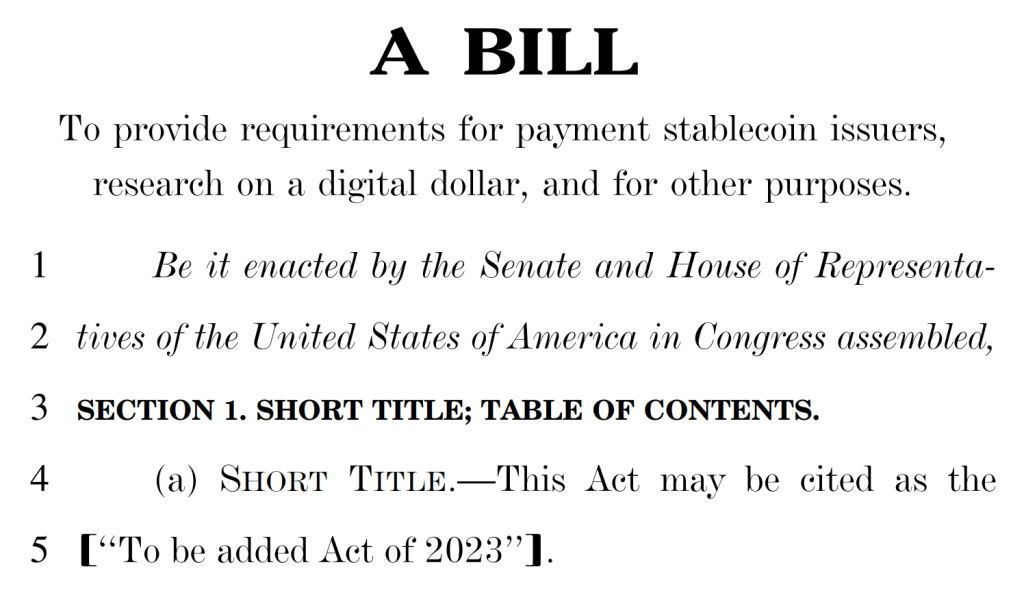The difference between a stablecoin and a CBDC is essential. A stable token is a cryptocurrency backed by some type of asset, such as the U.S. dollar, to maintain its stability and avoid volatility.
- CBDC and stablecoins have critical differences.
- The use of the U.S. Dollar as a reserve currency is changing.
- Djed, the ADA-backed stablecoin, has reached an all-time high of 4.24 million coins minted.
Differences between Stablecoins and CBDCs. A Central Bank Digital Currency is a digital form of fiat money issued and backed by a central bank, similar to the Federal Reserve in the United States. The new bill in the U.S. proposes a study of a digital Federal Reserve dollar, but how lawmakers elaborate the statement suggests a need for more knowledge of the nature of CBDCs. The Federal Reserve is already studying CBDCs and is working on developing an account of its own.
A Digital Federal Reserve Dollar?
The bill appears to be using the terminology “digital dollar” in a confusing way and may suggest creating a stable token backed by the Fed rather than a true CBDC. We’ll have to see if they get their facts straight. The importance of a CBDC lies in the central bank’s ability to control the money supply and monetary policy, which is impossible with stable asset-backed tokens. If the Fed issues a CBDC, it would have much greater control over the money supply and, thus, the economy. However, giving a Fed-backed stable token would not provide this same control.
The potential issuance of a CBDC also has international implications. Since most international community transacts using U.S. dollars, a CBDC could change how they make these transactions and use the dollar as an international reserve currency. In addition, if other central banks issue their CBDCs, it could change the dynamics of the global financial system and the function of the dollar as a reserve currency.
The U.S. Dollar as a reserve currency
The U.S. dollar has been the world’s leading reserve currency for over 70 years. Countries, corporations, and people use it for various purposes, including trade, investment, and debt financing. However, the use of the dollar is declining. There are many reasons for this decline, including the following:
- The rise of other currencies. China’s renminbi (RMB) is one of the currencies challenging the dollar’s dominance. The RMB is the world’s second-largest currency by trading volume, increasingly used for trade and investment. Other currencies that are gaining in popularity include the euro, the Japanese yen, and the British pound.
- The growing use of digital currencies. Digital currencies, such as Bitcoin, are not subject to government control, making them attractive to some investors, who see them as a hedge against inflation and political instability. The use of digital currencies is still in its early stages, but it is snowballing.
- The U.S. government’s fiscal policies. The U.S. government has been running large budget deficits for many years. This problem has led to concerns about the sustainability of the U.S. debt, making the dollar less attractive to investors.
- The U.S. economy. The U.S. economy is more robust than it once was, making the dollar less attractive to investors looking for currencies backed by stable economies.
The decline of the dollar has some implications:
- It makes it more difficult for the U.S. government to finance its debt.
- It makes it more expensive for U.S. companies to do business overseas.
- It makes it more difficult for the U.S. to influence the global economy.
We still have to determine how far the dollar’s decline will go. However, the dollar is no longer the unquestioned leader of the global currency system. The rise of other currencies, the growing use of digital currencies, and the U.S. government’s fiscal policies all contribute to the dollar’s decline.


The U.S. stable token bill
In summary, the proposed U.S. stablecoin bill [PDF] has positive and negative aspects. The ban on stable algorithmic tokens is a positive move, as these currencies are unstable and could pose a risk to users, according to them, of course. The regulatory framework for issuers of stablecoins, however, could be overly paternalistic and limit innovation. In addition, the confusion between a true CBDC and a Fed-backed stable token is troubling. It suggests a need for more understanding of a true CBDC in the global economy and financial system.
Ultimately, deciding to issue a CBDC is complex and requires careful consideration. The Federal Reserve is already studying the feasibility of a CBDC. It should decide on whether or not to issue one based on the needs of the global economy and financial system.
Djed, the ADA-backed stablecoin, hits an all-time high
Cardano’s stablecoin has recently reached an all-time high in circulation. Djed has reached more than 4.24 million coins minted, according to its official site. Cardano’s blockchain token, ADA, backs Djed, an overcollateralized stablecoin. It uses SHEN as a reserve currency.
One of the most notable aspects of Djed is its 400% reserve ratio, which means that its current circulating supply is backed by four times the amount of its circulating coins, helping Djed become a more stable and trusted option for users. Currently, the current circulating supply of Djed has 16.89 million Djed, equivalent to 38.7 million ADA. Interestingly, the unparalleled minting of Djed coincided with two other attention-grabbing developments.
For one, according to CoinMarketCap data, Djed’s trading volume increased by more than 17% in the last days. The beginning of the month also saw an increase in stablecoin trading volumes. It is also important to highlight that COTI had a 30% growth in its quotes last week. COTI is a native token of the group of the same name that issues Djed. The price of its token has been performing better in the last few days. COTI holders and stakers receive revenue from Djed’s turnover.
